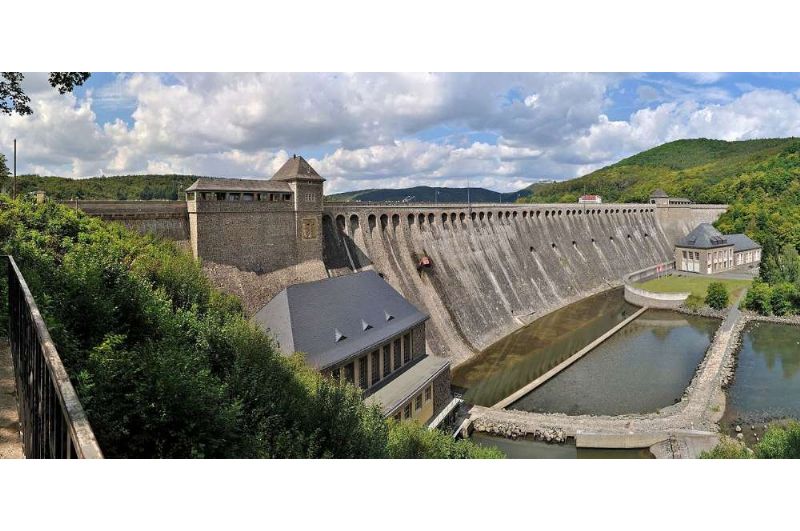Sperrmauer Museum Edersee
The museum near the Edertal dam is a reminder of the RAF's Operation Chastise, carried out on May 17, 1943, to destroy the dam with bouncing bombs.
The Edertal dam and its reservoir, the Edersee, form the second-largest reservoir in terms of surface area (11.8 km2) and the third-largest dam reservoir (capacity 199,300,000 m3) in Germany. The 48 m-high structure is built on the Eder, a tributary of the Fulda, near the town of Waldeck in the district of Waldeck-Frankenberg (northern Hesse).
During the World War II, the dam was destroyed by bouncing bombs dropped by the Royal Air Force during Operation Chastise. Partially destroyed, it was rebuilt in a few months thanks to forced laborers from the Todt Organization.
During the World War II, the Royal Air Force hoped, through Operation Chastise, deprive the Ruhr armaments industry of raw materials and drinking water by destroying the Möhne, Sorpe, Ennepe and Lister dams. The plan also called for the bombing of the l'Edertal dam, whose destruction would prevent navigation on the Weser for several months and put the Mittellandkanal out of business.
On May 17, 1943, just before 2:00 am, a bombardment carried out by British squadron No. 617, commanded by Lieutenant-Colonel Guy Gibson (Dam Busters) dealt a fateful blow to the Ederstal dam.
To thwart the anti-bomb nets covering the downstream end of the dam, the British had devised a special weapon, the ricochet bomb, intended for release by Avro Lancasters. These projectiles, which were given a rotating motion, were supposed to bounce off the surface of the lake right down to the bottom of the nets, before exploding at a predetermined depth. The shockwave on the Edertal dam was enough to open a breach 22 m high and 70 m wide at the crown. The water surged at an average rate of 8,000 m3/s, releasing a total of 160,000,000 m3 of water, representing 80% of the dam's volume.
The Edersee dam after the 1943 bombing.
A wave 6-8 m high formed downstream, heading towards Fritzlar, Wabern and Felsberg to flood the Fulda (Cassel) Weserstein (Hann. Münden) valleys and eventually swell the waters of the Weser. The flood wave, described by local residents as a roaring roll of white foam, destroyed hundreds of houses, several factories, railroads, bridges and roads, and uprooted hundreds of trees. The flood didn't just submerge neighboring valleys such as the Schwalm-Eder confluence and the Eder-Fulda confluence into lakes: it drowned the Fulda depression in the Cassel basin, some 35 km downstream, so that Bettenhausen, the valley suburbs and Karlsaue Park with its orangery were swept away by the flood.
Estimates of the number of victims who perished, directly or indirectly, in this flood are contradictory: they oscillate between 47 and 68 deaths. Some works from the early 21st century, which refer to the death of 749 Ukrainian prisoners of war from a labor camp downstream of the Edersee dam, are probably confusing this with the Möhne disaster (another part of Operation Chastise), which followed the bombing of the Möhne dam: There are no sources to confirm that there was a forced-labor camp downstream from Lake Edersee at the time of the bombing; the deportees assigned to rebuilding the dam were installed in a camp specially set up for this work.
An amateur film made by a soldier shows the water pouring through the gaping fault in the dam just hours after the air attack.
Photo credit kaʁstn Disk/Cat and Bild 183-C0212-0043-012



